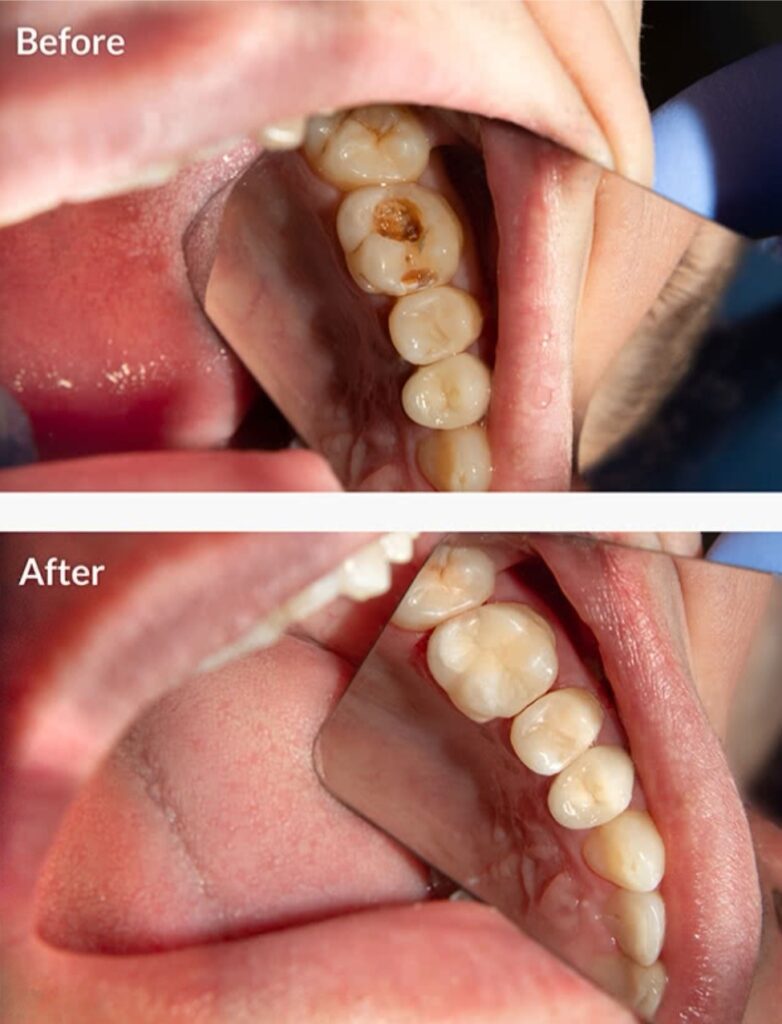DENTAL FILLINGS
WHY DO I NEED DENTAL FILLINGS?
You may need a dental filling for a variety of reasons, but the primary purpose of a filling is to restore a tooth that has been damaged by decay or other issues. Here are some common reasons why you might need a dental filling:
1)Tooth Decay (Cavities): The most common reason for needing a dental filling is tooth decay. Bacteria in your mouth produce acids that can erode the enamel of your teeth, leading to cavities or holes in the tooth structure. A dental filling is used to fill and seal the cavity, preventing further decay and restoring the tooth’s function and appearance.
2)Cracked or Fractured Teeth: Teeth can crack or fracture due to various factors, such as trauma, chewing on hard objects, or even biting down on something unexpectedly. A filling may be used to repair the tooth and prevent the crack from worsening.
3)Worn Teeth: Teeth can become worn down over time due to factors like teeth grinding (bruxism), acid erosion, or even excessive brushing with a hard toothbrush. Fillings can help restore the proper shape and function of the tooth.
4)Chips or Breaks: If a small piece of a tooth chips off or breaks, a dental filling can be used to repair the damage and restore the tooth’s integrity.
5)Cosmetic Reasons: Dental fillings can also be used for cosmetic purposes, such as filling in gaps between teeth or reshaping teeth for a more aesthetically pleasing appearance.
6)Replacing Older Fillings: Over time, older dental fillings (such as silver amalgam fillings) can deteriorate, become worn, or develop leakage around the edges. Replacing these older fillings with new tooth-colored composite fillings can improve both the appearance and function of your teeth.


WHAT ARE THE DIFFERENT OPTIONS FOR DENTAL FILLINGS .
There are several different options for dental fillings, each with its own set of advantages and considerations. The choice of filling material depends on factors such as the location of the tooth, the extent of the damage, your oral health, and your personal preferences. Here are some common types of dental fillings:
Composite Fillings (Tooth-Colored Fillings): Composite fillings are made of a mixture of plastic and glass materials. They are matched to the color of your natural teeth, making them a popular choice for visible areas of the mouth. Composite fillings bond directly to the tooth structure, which can provide additional support. They are versatile and can be used for both small and moderate-sized fillings.
Amalgam Fillings: Amalgam fillings, also known as silver fillings, are made from a combination of metals, including silver, tin, copper, and mercury. They have been used for many years and are known for their durability and strength. However, they are silver in color and may not be as aesthetically pleasing as tooth-colored fillings. There has been some debate about the safety of mercury in amalgam fillings, although many dental organizations consider them safe.
Porcelain Fillings (Inlays and Onlays): Porcelain fillings, also known as inlays and onlays, are custom-made restorations that are created in a dental laboratory and then bonded to the tooth. They provide a natural appearance and are often used for larger cavities or when a significant portion of the tooth is damaged. Porcelain inlays fit within the cusps of the tooth, while onlays extend over one or more cusps.
Glass Ionomer Fillings: Glass ionomer fillings are a blend of acrylic and glass materials. They are often used for fillings in areas of the mouth with less stress, such as non-chewing surfaces or baby teeth. Glass ionomer fillings can release fluoride over time, which can help prevent further decay.
Ceramic Fillings: Ceramic fillings are made from porcelain or other ceramic materials. Like porcelain inlays and onlays, they are fabricated in a dental laboratory and then bonded to the tooth. They provide an excellent natural appearance and are resistant to staining. Ceramic fillings are a good choice for patients who have allergies or sensitivities to other filling materials.
Your dentist will evaluate your dental health and discuss the available options with you to determine the best type of filling for your specific needs. It’s important to consider factors such as appearance, durability, location, and cost when making your decision. Contact us for your best treatment.


